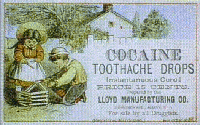Heroine was used for children’s syrups 100 years ago
Many of the substances prohibited today were legally available in the past. The prohibition of psychoactive substances has evolved gradually in the United States and in Europe. The opium-containing preparation laudanum had been widely available since the 18th century. Morphine, cocaine, and even heroin were seen as miracle cures when they were first discovered. During the mid to late 19th century, many manufacturers proudly proclaimed that their products contained cocaine or opium.

A few, like Mrs. Winslow's Soothing Syrup for infants which contained morphine, were more guarded in divulging their principal ingredients. By the beginning of the 20th century, problems with habitual use of cocaine and opiates was becoming increasingly apparent. This led to the removal of these substances from some products (e.g., Coca Cola) and to the introduction of the Pure Food and Drug Act (1906) in the United States which required the listing of ingredients on product labels.
Nonetheless, standard narcotic remedies like paregoric remained readily available into the early 20th century, and Benzedrine inhalers were marketed without prescription until the early 1950s. Codeine wasn't removed from most over-the-counter cough suppressants until the early 1980s.
1. Cocaine-Containing Products
There were three types of medicines often containing cocaine-topical anesthetics such as toothache powders, catarrh medicines for relieving head and chest congestion, and medicinal (probably also recreational) cocaine-containing wines advocated for their numerous beneficial effects.
Cocaine is an effective local anesthetic, and some of the earliest uses of cocaine was for its local anesthetic properties. Today, other compounds such as lidocaine and procaine are the medically preferred local anesthetics. These compounds do not produce the mood-elevating and euphorigenic "side effects" that can occur with cocaine.
Cocaine toothache drops were popular with children and with their parents. Not only would the medicine numb the pain, but it could also put the user in a "better" mood.
Cocaine-containing throat lozenges, "indispensable for singers, teachers, and orators." In addition to quieting a sore throat, these lozenges undoubtedly provided the "pick-me-up" to keep these professionals performing at their peak. This box of lozenges is from a Belgium pharmacy (c. 1900). Local pharmacies often bought their drugs in bulk and packaged them for consumers under their own labels.
Cocaine-containing wines were very popular and there were many companies competing in the lucrative coca-wine market. Vin Mariani is the most recognized and perhaps the most popular at the time, but many other brands were produced in the United States and abroad.
Burnett's Cocoaine (c. 1880) contained coconut oil not cocaine as its primary ingredient. Hoping to capitalize on the popularity of products containing cocaine and their association with "modern medicine," some manufacturers developed similarly sounding proprietary names. Burnett's Cocoaine bottles are bought and sold by many modern collectors who mistakenly believe the product contained cocaine. They must be similarly confused about the nature of "cocoa" and "coca" products. ("Cocoanut" is also a variant spelling of "coconut," and hence the aptly named product.)
2. Opiate-Containing Products
Opiate-based formulations were probably even more widely employedthanthosecontaining cocaine.Laudanum had been in use for over two centuries, and the isolation of morphine in the early 19th century (c. 1803/1817) and the later development of heroin (c. 1898) were lauded as even more effective remedies.
Modern authors usually suggest that widespread opium use was a major health problem during the 19th century. However, the use of opiates must be kept in proper perspective with other contemporary health problems. Mortality from cholera, malaria, and dysentery was very high, and opiates provided some relief from these illnesses (Opiates remain the most effective treatment for dysentery).
Some authors have suggested that the easy availability of opiate-based medicines saved more lives than it took. As the deleterious effects of chronic opiate use became increasingly recognized during the late 19th century, several factors helped ease the need for opiates: the improvements in sanitation diminished cholera and dysentery, the drainage of swamp lands decreased malaria, and the introduction of acetylsalicylic acid (aspirin; 1899) provided an alternative medicine for moderate pain relief.
Stickney and Poor's paregoric was distributed much like the spices for which the company is better known. McCormick also manufactured and sold paregoric, which is a mixture of opium and alcohol. Doses for infants, children, and adults are given on the bottle. At 46% alcohol, this product is 92 proof which is pretty potent in itself.
Mrs. Winslow's Soothing Syrup was an indispensable aid to mothers and child-care workers. Containing one grain (65 mg) of morphine per fluid ounce, it effectively quieted restless infants and small children. It probably also helped mothers relax after a hard day's work. The company used various media to promote their product, including recipe books, calendars, and trade cards such as the one shown here from 1887 (A calendar is on the reverse side.).
Opium smoking was another common method of administering opium. Although often associated with the Chinese, opium smoking was much more widespread and especially popular with some affluent occidentals. Various media, such as this postcard from San Francisco (c. 1900), encouraged the popular stereotype. In addition to the "recreational" effects produced by smoked opium, certain medicinal effects were also produced. These effects were similar to those produced by Glyco-heroin, paregoric, and other opiate-containing medications. (cf. Vapo-OL [opium] Treatment no. 6 for asthma illustrated above.)
3. Amphetamine-Containing Products
Amphetamine was synthesized too late to have the widespread applications enjoyed decades earlier by cocaine and the opiates. It was, however, marketed in products commonly used to relieve head congestion and asthma. Amphetamine continued to be employed as a popular prescription diet-aid into the 1970s.
Benzedrine (racemic amphetamine) inhalers were available over-the-counter until the early 1950s. Some airlines even gave them out to passengers to minimize discomfort when the plane was landing and taking off. The Smith, Kline, and French advertisement proudly proclaims that over 10 million Benzedrine inhalers had been shipped by 1938, only 7 years after the product's introduction. This may have even outpaced McDonald's hamburger sales during their early expansion (Remember the "over x million hamburgers sold" signs on the golden arches?).
Source: Buffalo University
Prepared by Alexander Timoshik
Pravda.ru
Subscribe to Pravda.Ru Telegram channel, Facebook, RSS!





